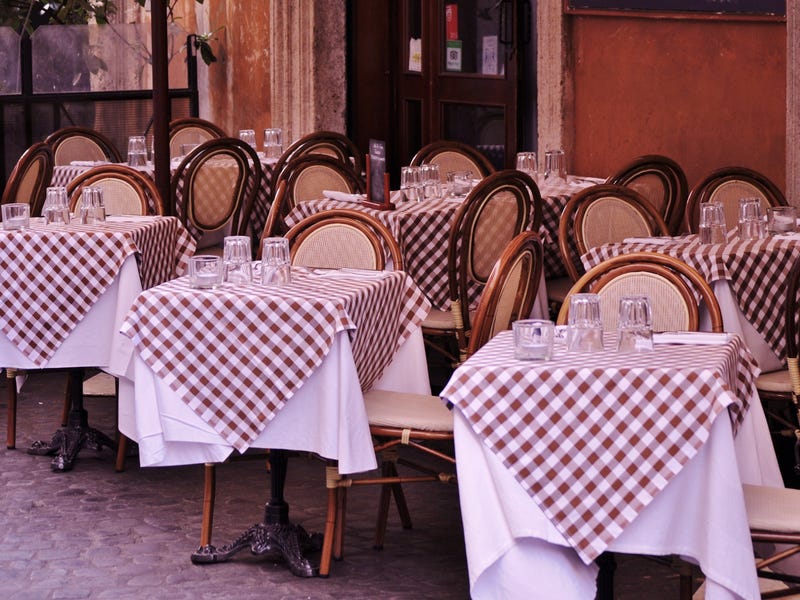Italy is undoubtedly renowned for many contributions to humankind: The Renaissance, opera, and neorealist films…but let’s face it, no intellectual achievement has been nearly as important and has had a bigger impact on the whole globe than Italian food culture.
Wherever you are from, if you think about Italy, probably the first thing that comes to mind is food. And even if, as Italians, we are convinced that food is, first of all, poetry, tradition, sharing, and caring, bare tasteless money can help us get a better idea of the immense power of Italian cuisine. According to Deloitte, in 2023, Italian cuisine was worth 228 billion euros (yes, billion), and it’s top in the world in terms of penetration of traditional restaurants. It’s not surprising, then, that even Greenland has a few pizza spots, and Antarctica will soon get its first, authentic pizza oven straight from Naples.
In other words, food and Italy are so connected that if you’re learning Italian you simply must - and should - dive into the Italian food culture…and if you’re a food lover, Italy is your number one place to be, so you might as well pick up a few useful sentences to pull off in Italian restaurants.
But let’s set grammar and terminology aside for now, and let’s tuck the napkin into our collars. It’s time to overstimulate our taste buds by diving into the flavors of Italy!
Are you just starting your Italian language journey? Download our complimentary Italian language essentials eBook here.

A brief history of Italian food
With its complex geography and its intricate history full of invasions and little states popping up and making war with each other, Italy is a very diverse country in terms of landscape and architecture. If on the Alps you have Swiss-like villages where people sometimes speak Italian with a thick German accent, in Sicily it’s Greeks and Arabs that have shaped the cities, together with the Normans and at least half a dozen other invaders. Then, of course, there were the Romans, with their culture that was a stir-fried mix of the many people they dominated.
While Italy as the country we know today was born as recently as 1861, its many food traditions have been developing for thousands of years more or less independently in each single region, city and even village, with the Mediterranean Sea and the roads (often built by Romans) as recipe exchange forums and an endless source of ingredients and discoveries.
If in recent times Italians have become more global in terms of taste, with sushi restaurants and kebab joints in almost every corner of the country, local traditions are still firmly at the top of their preferences. After all, let’s not forget that this is the country where a local bread put McDonald’s out of business!
Italian cuisine is still a complex puzzle of traditions, often very different from one another, that not only resist but flourish in the new millennium. And that’s all the beauty and flavor of it! In this article, you’ll find a list of Italian dishes you should try, along with some interesting facts about Italian cuisine you should definitely know.
What you need to know about Italian food culture
Now, let’s see some facts about Italian dishes, cuisine, and culture that you might not know.
Italian cuisine is very diverse
As we’ve already mentioned, the greatest richness of Italian food is undoubtedly its diversity. If in Sicily and Southern Sardinia, couscous is one of the most appreciated traditional dishes. In the far northern region of Trentino Alto Adige, you’ll find strudel, spätzle (spinach gnocchi), canederli, and other dishes that are also common in Austria and Hungary.
Even small towns often have their own, unique specialties. Just think about Recco, with its world-famous cheese focaccia, which only has around 9.000 residents!
Pro tip: when you travel to a certain Italian region, city, or town, always look for the local dishes!
Yes, most Italians eat pasta everyday
But don’t think that this makes our cuisine boring! A local survey has counted around 300 varieties of pasta commonly used in the country, with an endless list of sauces. Basically, you could travel throughout Italy from January 1st to the end of October and eat one different kind of pasta every single day.
Some of the most famous Italian dishes do not exist in Italy
If you love fettuccine Alfredo, spaghetti with meatballs, spaghetti bolognese, chicken parmigiana, or pineapple pizza…well Italy is not the right place for you. Only a handful of very touristy restaurants serve them, and you should not eat there. No one should.
A typical Italian meal is four courses
Even if most Italians do not eat like this every day - because who has the time - it’s very common on a family Sunday lunch or at a restaurant to have at least four courses: antipasto (appetizer), primo (a carb-based dish like pasta or risotto, or a soup), secondo (meat, fish, or a vegetarian dish accompanied by vegetables or potatoes), and dolce (dessert). We rigorously eat them in this order, you won’t have pasta as a side dish for a steak!
What is Italy’s national dish?
Drop this question into a room full of Italians, and you’ll immediately hear the decibels go up and feel the temperature spike like in a hot August afternoon. But we all agree that there’s one Italian cuisine specialty that unites the whole country and can be found everywhere, from Lampedusa to the Valle d’Aosta, and that’s pizza!
Born in Naples in its most classical form - the Margherita - to honor the Queen Margherita with a dish that displayed all the colors of the newborn Italian flag (the red tomatoes, the white mozzarella, and the green basil), pizza has since expanded to embrace a multitude of condiments, generate several regional varieties (of course), and give birth to an infinite number of restaurants in the entire world.

Italian breakfast foods
Compared to other traditions, Italian breakfast foods are relatively light. Italians don’t usually eat much for breakfast, and would rather have a richer lunch. But nonetheless, we have a few delicious specialties for the morning birds.

Focaccia
Take a slice of perfectly salty and oily focaccia and a nice cappuccino, and you’ll have the typical Ligurian breakfast. You can have it in a beautiful café facing the Mediterranean Sea, and then take your towel and go to the beach.
Maritozzo
Would you rather start your day with something sweet? Then we suggest you travel to Rome and order a maritozzo. This sweet bread filled with handmade whipped cream is like heaven smiling at you.
Granita e brioche
Let’s travel farther south, specifically to Sicily, where temperatures are mild even in the middle of winter and summers are scorchingly hot. It’s not surprising, then, that people here love a cold breakfast: a brioche (a sort of sweet bread) with a delicious granita, a dessert made of crunchy ice flavored with almond milk, fruit syrup, or even coffee.
Italian appetizers
Are you ready to start your meal? In Italy, we say “l’appetito vien mangiando” (appetite comes when eating), and that’s exactly what Italian antipasti are for: to make you want to eat more Italian dishes!

Salumi e affettati
Prosciutto crudo, salame, pancetta, lardo, bresaola, mortadella…Italian food culture includes a world of cured meat delicacies that are often served as antipasto, usually with some olives and pickled vegetables.
Fiori di zucca fritti
Take a zucchini flower, stuff it with mozzarella and anchovies in oil, dive it into batter, and deep fry it. No better use of a flower was ever made.
Prosciutto e melone
One of the most widespread summer antipasto is a combination of a freshly sliced, sweet cantaloupe and a savory prosciutto di Parma.
Carpaccio
This thinly sliced, high-quality beef meat is seasoned with arugula, flakes of Parmesan cheese, and olive oil, and eaten raw.
Impepata di cozze
Italian fare is often very simple. It is so simple that this delicious dish only has two ingredients: mussels and black pepper. If you want, you can add garlic and parsley.
Italian first courses, aka “primi”
Now that you’ve warmed up, it’s time to get serious. Let’s see a few authentic Italian “primi” dishes.

Tagliatelle al ragù
The authentic version of “spaghetti bolognese” is made with tagliatelle, a kind of egg pasta, and “ragù alla bolognese," which is a sauce with beef and pork meat that’s cooked for at least four hours.
Penne all’arrabbiata
One of the simplest and yet most delicious Italian recipes. The sauce is only tomato, olive oil, garlic, parsley, and red chili pepper.
Spaghetti alla carbonara
Maybe the most misunderstood Italian dish, this Roman sauce is made with pecorino cheese, raw eggs, guanciale, and black pepper. Nothing else!
Risotto alla milanese
Let’s move to the north, the land of Risotto! Risotto alla milanese is an explosion of flavors with a beautiful golden color, thanks to saffron.
Trofie al pesto
This ligurian primo is as simple as it looks: pesto, trofie (a kind of fresh pasta), and, if you want to really go local, boiled potatoes and green beans.
Spaghetti allo scoglio
No Italian summer is complete without a huge plate of spaghetti and seafood!
Tortellini in brodo
Even if in Italian(ish) restaurants around the world the tortellini are mostly covered in cream, the classic way to eat them is in a tasty, rich broth with a sprinkle of Parmesan cheese.
Italian second dishes, aka “secondi”
Do you think you’re full? Well, think again because now we have the “secondi” coming!

Brasato al Barolo
This luxurious dish is a braised meat that slowly cooks, covered in Barolo wine.
Parmigiana di melanzane
A vegetarian secondo that’s a masterpiece of Italy and is made with fried eggplant slices, mozzarella, tomato sauce, parmesan, and basil.
Fegato alla Veneziana
Venice’s simplest and yet most iconic secondo is a dish that not everyone will like, and which is made with sliced beef liver and onions.
Coniglio alla ligure
The number one Sunday secondo in every Ligurian family, this rabbit stew is enriched with black olives, pine nuts, white wine, and herbs.
Seppie e piselli
This cuttlefish and pea stew is a light secondo that’s perfect for seafood lovers.
Italian desserts
Let’s end this Italian culinary list on a sweet note filled with Italian desserts!

Tiramisù
The most famous Italian dessert is pretty young: it was created in 1970 in Treviso (not far from Venice) by a chef named Loly Linguanotto. You can thank him at his website.
Cannolo siciliano
This Sicilian dessert is a thin wafer filled with a gorgeous ricotta cream.
Pannacotta
A real classic of Italian cuisine, this dessert is based on milk cream and perfumed with vanilla.
Seadas
You will only find this dessert in Sardinia or in Sardinian restaurants around the world, but we swear it’s worth a trip. Imagine a big raviolo, filled with savory cheese, deep-fried, and covered in honey. Doesn’t it look good?
Babà napoletano
This Neapolitan dessert is a tender, lightly sweet cake generously soaked with rum.
Embrace Italian culture with a language course!
Did this article make you hungry for even more Italian culture? Treat yourself to a funny, engaging, comprehensive Italian language course! Find the perfect option for your level, interests, and preferences, and learn Italian in a flexible environment at your own pace!



